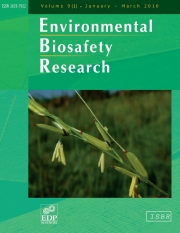Crossref Citations
This article has been cited by the following publications. This list is generated based on data provided by
Crossref.
Alpert, Carl-Alfred
Mater, Denis D.G.
Muller, Marie-Claude
Ouriet, Marie-France
Duval-Iflah, Yvonne
and
Corthier, Gérard
2003.
Worst-case scenarios for horizontal gene transfer fromLactococcus lactiscarrying heterologous genes toEnterococcus faecalisin the digestive tract of gnotobiotic mice.
Environmental Biosafety Research,
Vol. 2,
Issue. 3,
p.
173.
Torres, Begoña
Jaenecke, Susanne
Timmis, Kenneth N.
García, José L.
and
Díaz, Eduardo
2003.
A dual lethal system to enhance containment of recombinant micro-organisms.
Microbiology,
Vol. 149,
Issue. 12,
p.
3595.
Kapuscinski, Anne R
Goodman, Robert M
Hann, Stuart D
Jacobs, Lawrence R
Pullins, Emily E
Johnson, Charles S
Kinsey, Jean D
Krall, Ronald L
La Viña, Antonio GM
Mellon, Margaret G
and
Ruttan, Vernon W
2003.
Making 'safety first' a reality for biotechnology products.
Nature Biotechnology,
Vol. 21,
Issue. 6,
p.
599.
Davison, John
2005.
Risk mitigation of genetically modified bacteria and plants designed for bioremediation.
Journal of Industrial Microbiology & Biotechnology,
Vol. 32,
Issue. 11-12,
p.
639.
Balan, Andrea
and
Schenberg, Ana Clara G.
2005.
A conditional suicide system forSaccharomyces cerevisiae relying on the intracellular production of theSerratia marcescens nuclease.
Yeast,
Vol. 22,
Issue. 3,
p.
203.
HILL, RYAN
and
SENDASHONGA, CYRIE
2006.
Conservation Biology, Genetically Modified Organisms, and the Biosafety Protocol.
Conservation Biology,
Vol. 20,
Issue. 6,
p.
1620.
Giacalone, Matthew J.
Zapata, Juan C.
Berkley, Neil L.
Sabbadini, Roger A.
Chu, Yen-Lin
Salvato, Maria S.
and
McGuire, Kathleen L.
2007.
Immunization with non-replicating E. coli minicells delivering both protein antigen and DNA protects mice from lethal challenge with lymphocytic choriomeningitis virus.
Vaccine,
Vol. 25,
Issue. 12,
p.
2279.
Daudel, Damini
Weidinger, Gerald
and
Spreng, Simone
2007.
Use of attenuated bacteria as delivery vectors for DNA vaccines.
Expert Review of Vaccines,
Vol. 6,
Issue. 1,
p.
97.
Kong, Wei
Wanda, Soo-Young
Zhang, Xin
Bollen, Wendy
Tinge, Steven A.
Roland, Kenneth L.
and
Curtiss, Roy
2008.
Regulated programmed lysis of recombinant
Salmonella
in host tissues to release protective antigens and confer biological containment
.
Proceedings of the National Academy of Sciences,
Vol. 105,
Issue. 27,
p.
9361.
Jäderlund, Lotta
Hellman, Maria
Sundh, Ingvar
Bailey, Mark J.
and
Jansson, Janet K.
2008.
Use of a novel nonantibiotic triple marker gene cassette to monitor high survival of Pseudomonas fluorescens SBW25 on winter wheat in the field.
FEMS Microbiology Ecology,
Vol. 63,
Issue. 2,
p.
156.
Gürakan, G
and
Altay, Neslihan
2009.
Development and Manufacture of Yogurt and Other Functional Dairy Products.
p.
97.
Kumar, Pradeep
and
Baul, Gayatri
2010.
Bioremediation Technology.
p.
245.
Liu, Yan
Wei, Qing
Wang, Shu-Jun
Liu, Hong
and
Zhou, Ning-Yi
2010.
Construction of an engineered strain free of antibiotic resistance gene markers for simultaneous mineralization of methyl parathion and ortho-nitrophenol.
Applied Microbiology and Biotechnology,
Vol. 87,
Issue. 1,
p.
281.
Ramos, Humberto J.O.
Yates, M. Geoffrey
Pedrosa, Fábio O.
and
Souza, Emanuel M.
2011.
Strategies for bacterial tagging and gene expression in plant-host colonization studies.
Soil Biology and Biochemistry,
Vol. 43,
Issue. 8,
p.
1626.
Monnappa, Ajay Kalanjana
Dwidar, Mohammed
and
Mitchell, Robert J.
2013.
Application of bacterial predation to mitigate recombinant bacterial populations and their DNA.
Soil Biology and Biochemistry,
Vol. 57,
Issue. ,
p.
427.
Ramos, Humberto J. O.
Yates, Marshall Geoffrey
Pedrosa, Fábio O.
and
Souza, Emanuel M.
2013.
Molecular Microbial Ecology of the Rhizosphere.
p.
909.
Jeon, Jong-Rok
Murugesan, Kumarasamy
Nam, In-Hyun
and
Chang, Yoon-Seok
2013.
Coupling microbial catabolic actions with abiotic redox processes: A new recipe for persistent organic pollutant (POP) removal.
Biotechnology Advances,
Vol. 31,
Issue. 2,
p.
246.
Torres, Begoña
García, José L.
and
Diaz, Eduardo
2014.
Plasmid Biology.
p.
589.
Azad, Md. Abul Kalam
Amin, Latifah
and
Sidik, Nik Marzuki
2014.
Genetically engineered organisms for bioremediation of pollutants in contaminated sites.
Chinese Science Bulletin,
Vol. 59,
Issue. 8,
p.
703.
GarcíA, José L.
Díaz, Eduardo
Tolmasky, Marcelo
and
Alonso, Juan Carlos
2014.
Plasmids as Tools for Containment.
Microbiology Spectrum,
Vol. 2,
Issue. 5,

